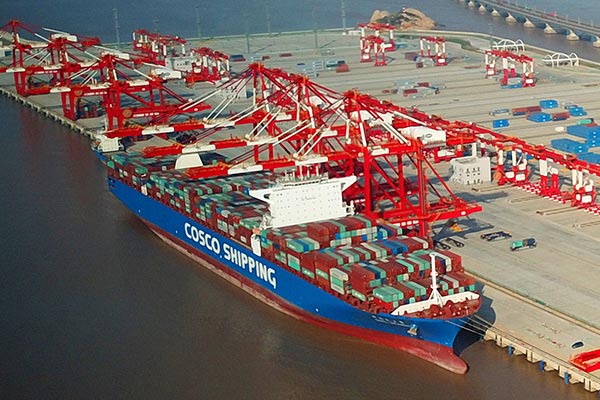
The fourth phase of the Yangshan Port project, also the last phase, starts operation. The automated terminal is the largest automation port worldwide to date.[Photo provided for China Daily]
A fully automated container terminal involving a total investment of 14 billion yuan ($2.15 billion) has started operating at Shanghai’s Yangshan Port, which means China has broken the monopoly of global suppliers in port automation solutions.
The automated terminal, or the fourth phase of the Yangshan Port project — part of Shanghai Port — has been designed to handle a maximum of 6.3 million TEUs (20-foot equivalent unit), making it the largest automation port worldwide to date. Its unique energy consumption structure should result in zero carbon dioxide or other emissions while allowing savings of up to 70 percent.
“The new facility will increase the annual capacity of Shanghai Port to more than 40 million TEUs last year, which marks SIPG is entering a new development phase,” said Yan Jun, president of the Shanghai International Port Group.
According to Yan, the automatic port intellectual production management control system, or TOS system, performs as the brain of the brand-new port that covers an area of 2.23 million square meters. The system was researched and developed independently by the 200-plus R&D staff of the Shanghai International Port Group.
“Before the establishment of the automation port, which is also the final part of the Port of Shanghai, there were around 20 automation ports in the world, all adopting automation port systems designed and developed by global suppliers,” said Yan.
To master the core technology of port automation solutions, an R&D team was formed three years ago, which succeeded establishing 12 standards, which are likely to become the Chinese automation port standards in the future.
Compared to its counterparts, the greatest advantage of the Yangshan-version TOS system is that it allows port machinery to perform loading and unloading at the same time, according to Yan.
“It was also worth mentioning that all of the port machinery was provided by Shanghai Zhenhua Heavy Industry Co Ltd (ZPMC), with 100 percent Chinese intellectual property rights,” said Yan.
Shanghai Zhenhua Heavy Industry Co Ltd, the world’s largest port machinery manufacturer, plans in the next decade to make automated container terminals a new growth engine of the company, said Song Hailiang, chairman of ZPMC and vice-president of China Communications Construction Co Ltd, during an earlier interview with China Daily.
The future of terminals lies in unmanned technology. Through remote control, intelligent container terminals will have better performance and lower operational costs than traditional ones, added Song.
“The experience learned from developing and operating the automation port will help us to acquire a full set of intellectual property rights, so that to make duplication of the port possible,” said Yan.
Currently, SIPG and ZPMC are looking forward to forming a commercialized operation model for automation port development, and some port operators are already showing an interest in their facilities.
Two decades ago, the Port of Shanghai was the only one in the Yangtze River Delta region on the list of the world’s top 100 ports. Back then, the number of containers it handled accounted for less than 2 percent of the global volume.
Thanks to years of efforts in policy support and innovative development, the Port of Shanghai surpassed the Port of Singapore to become the world’s largest container port in 2010. It has retained the title since then, and saw its container operating volume rise for seven consecutive years. A total of 37.13 million TEU containers were dealt with by the Port of Shanghai throughout 2016.
From January to November of 2017, SIPG handled 520 million metric tons of cargo, up 10 percent year-on-year, and operated 36.88 million TEUs of containers during the same period, 8.3 percent more than that of last year, marking a new record.
